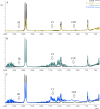Biodegradation of polyethylene in digestive gland homogenates of marine invertebrates
- PMID: 38426135
- PMCID: PMC10903337
- DOI: 10.7717/peerj.17041
Biodegradation of polyethylene in digestive gland homogenates of marine invertebrates
Abstract
Вiotic factors may be the driving force of plastic fragmentation along with abiotic factors. Since understanding the processes of biodegradation and biological depolymerization of plastic is important, a new methodological approach was proposed in this study to investigate the role of marine invertebrate digestive enzymes in plastic biodegradation. The aim of this study is to evaluate the possibility of enzymatic biodegradation of polyethylene fragments in the digestive gland homogenate of marine invertebrates differing in their feeding type (Strongylocentrotus nudus, Patiria pectinifera, Mizuhopecten yessoensis). Significant changes are found in the functional groups of the polymer after 3 days of incubation in the digestive gland homogenates of the studied marine invertebrates. A significant increase in the calculated CI (carbonyl index) and COI (сarbon-oxygen index) indices compared to the control sample was observed. The results suggest that digestive enzymes of studied organisms may play an important role in the biogeochemical cycling of plastic.
Keywords: Biodegradation of plastic; Fourier transform infrared spectroscopy.
© 2024 Istomina et al.
Conflict of interest statement
The authors declare that they have no competing interests.
Figures
Similar articles
-
Marine bacterial biodegradation of low-density polyethylene (LDPE) plastic.Biodegradation. 2021 Apr;32(2):127-143. doi: 10.1007/s10532-021-09927-0. Epub 2021 Feb 5. Biodegradation. 2021. PMID: 33544248
-
Biodegradation of low-density polyethylene by Microbulbifer hydrolyticus IRE-31.J Environ Manage. 2020 Jun 1;263:110402. doi: 10.1016/j.jenvman.2020.110402. Epub 2020 Mar 10. J Environ Manage. 2020. PMID: 32174537
-
Biodegradation efficacy of selected marine microalgae against Low-Density Polyethylene (LDPE): An environment friendly green approach.Mar Pollut Bull. 2023 May;190:114889. doi: 10.1016/j.marpolbul.2023.114889. Epub 2023 Mar 31. Mar Pollut Bull. 2023. PMID: 37004472
-
Biodegradation of Typical Plastics: From Microbial Diversity to Metabolic Mechanisms.Int J Mol Sci. 2024 Jan 2;25(1):593. doi: 10.3390/ijms25010593. Int J Mol Sci. 2024. PMID: 38203764 Free PMC article. Review.
-
A mini-review: current advances in polyethylene biodegradation.World J Microbiol Biotechnol. 2020 Feb 14;36(2):32. doi: 10.1007/s11274-020-2808-5. World J Microbiol Biotechnol. 2020. PMID: 32060663 Review.
References
-
- Almond J, Sugumaar P, Wenzel MN, Hill G, Wallis C. Determination of the carbonyl index of polyethylene and polypropylene using specified area under band methodology with ATR-FTIR spectroscopy. Polymers. 2020;20(1):369–381. doi: 10.1515/epoly-2020-0041. - DOI
-
- Alshehrei F. Biodegradation of synthetic and natural plastic by microorganisms. Applied and Environmental Microbiology. 2017;5:8–19. doi: 10.12691/jaem-5-1-2. - DOI
MeSH terms
Substances
LinkOut - more resources
Full Text Sources
Miscellaneous



